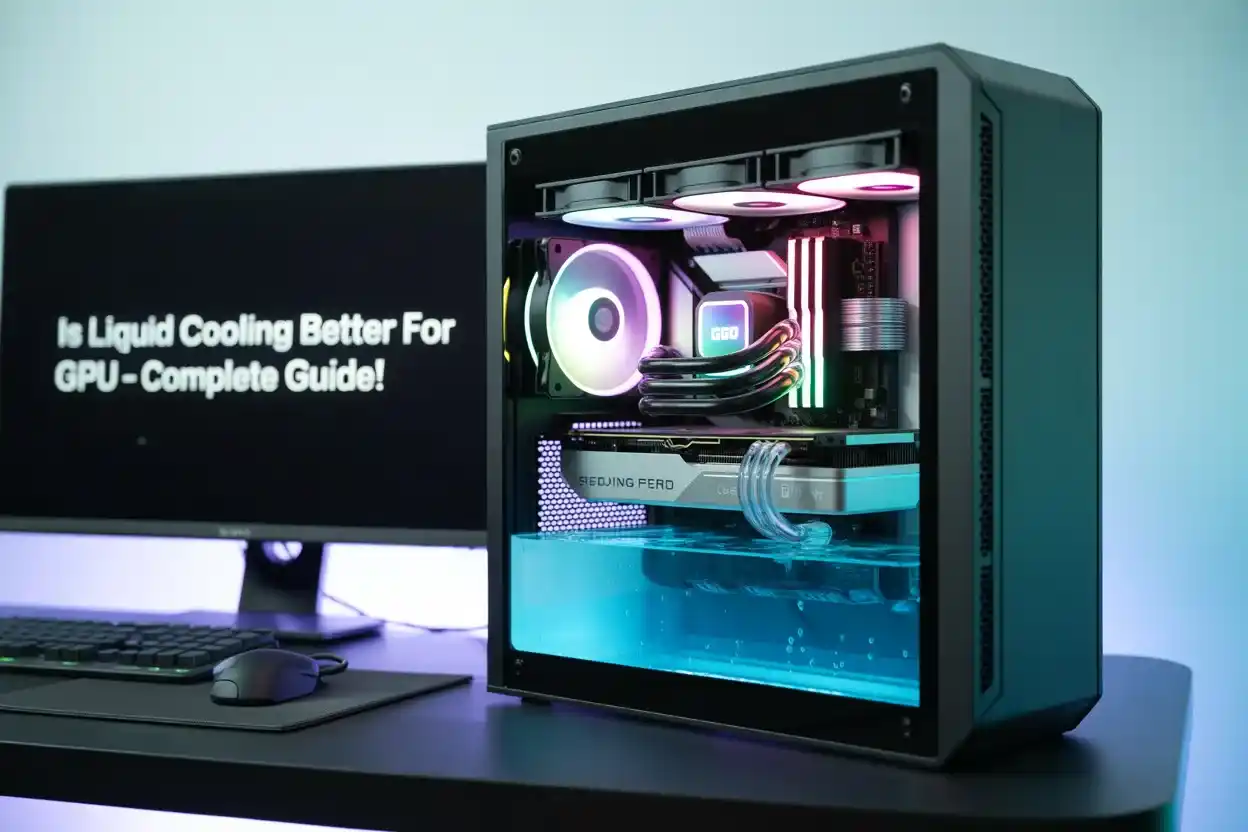Liquid cooling is better for the GPU because it keeps the card cool, quiet, and stable during gaming or heavy work. It also helps the GPU last longer by reducing heat stress. However, it is more expensive and requires careful setup, as well as regular maintenance.
In this guide, we will outline the real benefits and drawbacks of liquid cooling, allowing you to determine if it is the best option for your GPU.
What Does Liquid Cooling Mean for a GPU?
Liquid cooling means using liquid instead of air to remove GPU heat. Coolant flows over the GPU block, absorbs heat, and carries it to the radiator, where fans release it. This method helps powerful GPUs stay cool, quiet, and stable during gaming or heavy tasks, compared to basic air cooling.
Why Is Liquid Cooling Better for GPUs Than Air Cooling?
Liquid cooling is better than air cooling because it lowers temperature faster, keeps noise low, and improves stability. Air cooling is cheaper but less efficient for high-end GPUs.
| Feature | Air Cooling | Liquid Cooling |
| Cooling Power | Moderate | Strong, stable |
| Noise | Louder fans | Quieter operation |
| Cost | Low | Higher |
How Liquid Cooling Works Inside a Graphics Card
A liquid cooling system works through a loop. A pump pushes coolant over the GPU block, carrying heat into tubes. The liquid moves to a radiator, where fans release the heat into the air. This cycle repeats, keeping the GPU cool even during heavy gaming, overclocking, or creative workloads.
Also Read:Is BeamNG CPU or GPU Intensive
Key Benefits of Liquid Cooling for GPU Performance
Liquid cooling offers multiple performance benefits:
- Keeps GPU temperatures lower and stable
- Reduces noise compared to fan cooling
- Prevents thermal throttling during heavy tasks
- Improves performance for overclocking
- Extends lifespan by reducing heat damage
These benefits make liquid cooling a strong choice for gamers, creators, and professionals using high-end graphics cards.
Can Liquid Cooling Increase GPU Lifespan?

Yes, liquid cooling can increase GPU lifespan. Heat damages GPU components slowly over time. By keeping the card cooler, liquid cooling reduces stress and extends usability. With proper maintenance, a liquid-cooled GPU often lasts longer than one that depends only on fans and standard air cooling methods.
Is Liquid Cooling Better for GPUs in Gaming PCs?
Liquid cooling is better for gaming PCs because it controls heat during long sessions. It maintains stable FPS and prevents loud fan noise. For competitive and 4K gamers, this makes a big difference. However, casual gamers using mid-range GPUs may not need liquid cooling, as air cooling is enough.
Does Liquid Cooling Boost FPS and Stability?
Liquid cooling does not directly boost FPS, but it prevents overheating and thermal throttling. This means the GPU can run at its maximum speed for longer, giving more stable performance. As a result, gameplay feels smoother, frame rates stay consistent, and heavy tasks are completed more efficiently without slowdowns.
Also Read:Where to Find GPU in Device Manager
Common Risks of GPU Liquid Cooling Systems
Liquid cooling has some risks if not maintained properly:
- Leaks from tubes or fittings
- Pump failure is causing overheating
- Coolant evaporation or clogging
- Higher cost compared to fans.
- More complex installation process
Using quality parts and doing regular maintenance reduces these risks and keeps the GPU safe for long-term use.
Is Liquid Cooling Better for GPUs in Small Cases?

Yes, liquid cooling is often better for GPUs in small PC cases with limited airflow. It transfers heat out of the case more efficiently than fans. However, fitting a radiator in compact builds can be tricky. Checking compatibility before installation is important to avoid issues with space and setup.
Maintenance Tips for a Liquid-Cooled GPU
To keep a liquid-cooled GPU safe and long-lasting, follow these tips:
- Check coolant levels every few months
- Clean the radiator and fans to remove dust
- Inspect tubes and fittings for leaks.
- Replace coolant as recommended.d
- Use quality parts for durability.
Regular maintenance ensures smooth performance and protects the GPU from overheating.
Cost Difference Between Liquid Cooling and Air Cooling
Air cooling is more affordable, while liquid cooling costs more because of extra parts.
| Factor | Air Cooling | Liquid Cooling |
| Price | Low (fans included) | High (pump, radiator) |
| Noise | Louder | Quieter |
| Efficiency | Moderate | Excellent for high-end |
Enthusiasts benefit most from liquid cooling, but casual users save money with air.
Who Should Consider Liquid Cooling for Their GPU?
Liquid cooling is ideal for users with powerful GPUs who require stability for extended periods. It suits gamers, content creators, and professionals doing 3D design, rendering, or video editing. Budget or casual gamers can rely on air cooling, but high-end users will see real value with liquid cooling setups.
FAQs’:
1. Does Liquid Cooling Make a GPU Quieter?
Yes, liquid cooling reduces noise by moving heat through coolant and radiators instead of small, fast fans.
2. Can Liquid Cooling Work with Any GPU?
No, only GPUs with compatible AIO kits or custom water blocks support liquid cooling.
3. Is Liquid Cooling Better for GPU Overclocking?
Yes, it keeps the GPU cooler, allowing higher and more stable overclock speeds.
4. Is Liquid Cooling Necessary for Every GPU?
No, entry-level and mid-range GPUs usually work fine with air cooling.
5. Is Liquid Cooling a Good Long-Term Investment for GPU?
Yes, it lowers heat stress and extends the lifespan of powerful GPUs.
Conclusion:
Liquid cooling is a powerful option for keeping GPUs cool, stable, and long-lasting. It works best for high-end graphics cards, gamers, and professionals who need top performance. While it costs more and requires maintenance, the benefits of lower heat, less noise, and smoother performance make it a smart choice for serious PC users.

